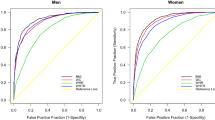Abstract
Obesity is a chronic disease that became a crisis on adult and child health worldwide, especially in Mexico where about 70 % of Mexican adults are overweight. Although several efforts have been made in order to take control over the problem, obesity as a disease is complicated to monitor and the solutions have had a limited success.In the other hand, disorder eating behaviors have been reported as an increasing health problem.Both clinical and anthropometric measurements can help on identify weight condition and in this paper we present an analysis of some of these attributes on a database devoted to identify the weight status of the subject. The data was collected from 600 records of a clinical laboratory in Mexico City and the attributes included cholesterol, LDL, HDL, body mass index (BMI) and waist measurement. We applied two classifiers to find out the way the classes are distributed and the possible relationship between the two categories of attributes. The classes were grouped in three categories (thinness, normal and obesity) and three levels of risk according to the experts for a total number of 28 classes. The results showed issues on severe thinness, medium and morbid obesity classes as well a strong impact of BMI on the classification of the obesity classes. The classification can be seen as an aid tool to help managing weight problems by an integral subject-centered strategy.
Preview
Unable to display preview. Download preview PDF.
Similar content being viewed by others
References
Rivera J, Velasco A, Hernandez M, et al (2013) Obesity in Mexico: recommendations for a state policy. UNAM, Mexico
Barquera S, Campos I, Hernández L, Pedroza A, & Rivera J (2013). Prevalence of obesity in Mexican adults 2000-2012. Salud Pública de México, 55(Suppl. 2), S151-S160. http://www.scielosp.org/scielo.php?script=sci_arttext&pid=S0036-36342013000800012&lng=en&tlng=es
Forbes at http://www.forbes.com.mx/obesidad-un-problema-de-5500-mdd-para-mexico/
Vázquez C, et al. (2015) Prevalencia de conductas alimentarias de riesgo y su asociación con ansiedad y estado nutricio en adolescentes de escuelas secundarias técnicas del Distrito Federal, México. Rev Esp Nutr Comunitaria 21(1), 15-21.
Kaufer M, Toussaint G (2008) Anthropometric indexes to evaluate pediatric overweight and obesity. Boletín médico del Hospital Infantil de México, 65(6), 502-518. http://www.scielo.org.mx/scielo.php?script=sci_arttext&pid=S1665-11462008000600009&lng=es&tlng=es.
World Health Organization (1995) Physical status: the use and interpretation of anthropometry: Report of a WHOS Expert Committee. WHO Technical report Series, Geneva, pp. 312, 345.
Tchernof A, Després JP (2013) Pathophysiology of human visceral obesity: an update. Physiological reviews, 93(1), 359-404.
Kesaniemi YA, Grundy SM (1983) Increased low-density lipoprotein production associated with obesity. Arteriosclerosis, Thrombosis, and Vascular Biology, 3:170-177 DOI: 10.1161/01.ATV.3.2.170
Grundy S, Pasternak R, Greenland P, Smith S, Jr, Fuster V (1999) Assessment of cardiovascular risk by use of multiple-risk-factor assessment equations: A statement for healthcare professionals from the American Heart Association and the American College of Cardiology1. J Am Coll Cardiol. 34(4):1348-1359 DOI:10.1016/S0735-1097(99)00387-3.
Morgan JF, Reid F, Lacey JH (1999) The SCOFF questionnaire: assessment of a new screening tool for eating disorders BMJ 319 :1467-1468.
WHO at http://apps.who.int/bmi/index.jsp?introPage=intro_3.html
Bishop C (2006) Pattern Recognition and Machine Learning, Springer
Hall M, Frank E, Holmes G, Pfahringer B, Reutemann P, Witten IH (2009); The WEKA Data Mining Software: An Update; SIGKDD Explorations, Volume 11, Issue 1.
Author information
Authors and Affiliations
Corresponding author
Editor information
Editors and Affiliations
Rights and permissions
Copyright information
© 2017 Springer Nature Singapore Pte Ltd.
About this paper
Cite this paper
Martinez-Licona, A.E., Martinez-Licona, F.M., Romero-Macias, J.C., del Castillo-Alfaro, L.A. (2017). Classification of Weight Status Using Anthropometric and Clinical Indicators. In: Torres, I., Bustamante, J., Sierra, D. (eds) VII Latin American Congress on Biomedical Engineering CLAIB 2016, Bucaramanga, Santander, Colombia, October 26th -28th, 2016. IFMBE Proceedings, vol 60. Springer, Singapore. https://doi.org/10.1007/978-981-10-4086-3_12
Download citation
DOI: https://doi.org/10.1007/978-981-10-4086-3_12
Published:
Publisher Name: Springer, Singapore
Print ISBN: 978-981-10-4085-6
Online ISBN: 978-981-10-4086-3
eBook Packages: EngineeringEngineering (R0)




